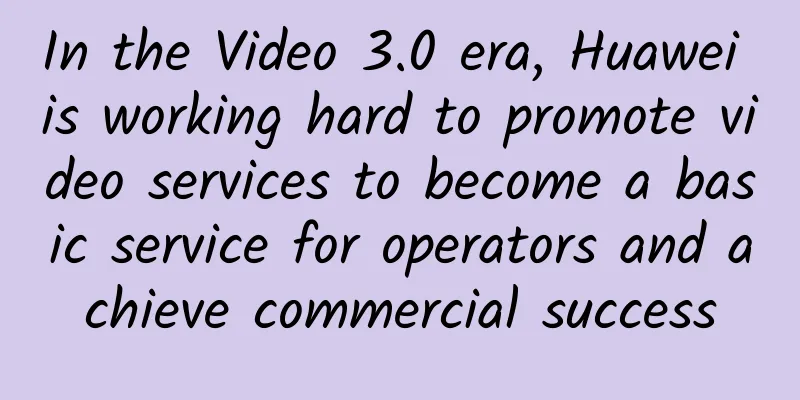In the Video 3.0 era, Huawei is working hard to promote video services to become a basic service for operators and achieve commercial success

|
[51CTO.com original article] In 2016, the three major operators in China added more than 50 million new video users, and the total number of users exceeded 100 million last year, which exceeded the development of the past decade in one year. At present, the three major operators all regard video as a basic business, but the understanding is not completely the same, and the development is also uneven. Although operators have many businesses, the most important ones are broadband and mobile phone businesses. However, some operators who are doing well not only regard video as a basic business, but also as a business that is as important as mobile phones and broadband. On this basis, they have achieved very good business success. How should we understand business success? How long will the window of opportunity for the development of video business last? How can Huawei help operators seize the initiative in video? Ruan Jianshan, President of the Telecommunications Software Business Department of Huawei China Region, shared his views with the media. Four new concepts realize Huawei's video strategic positioningRuan Jianshan said that Huawei's video strategic positioning has two key points: first, to promote video to become a basic business of operators; second, to help operators' video business achieve commercial success. This is Huawei's strategic goal that will not waver for many years to come. So how should we understand this business success? Ruan Jianshan believes that on the one hand, the development of 50 million video users last year is a good momentum, but this does not mean that the operator has achieved success. Huawei believes that what is more important is to drive the development of broadband and mobile phone services through video, to achieve an increase in overall revenue, overall profit, and overall market share. To achieve this goal, Huawei believes that the end-user experience is the core, the network is the foundation, the product is the key, and execution is the guarantee. Ruan Jianshan told reporters that Huawei has proposed four new concepts: new platform, new experience, new network, and new ecology. Among these four new things, the new experience is the most important, and Huawei will continue to give it new connotations in the future. The new experience also includes the process from the end user's contact with the operator, from the salesperson in the business hall marketing to the process of installation and maintenance personnel installing broadband and video at home, to the process of watching, and then to the process of asking the operator for help when problems arise. Huawei believes that all the contacts between the end user and the operator, and the ultimate experience around the end-to-end touchpoints of video are the most important. It is different in China and overseas. In overseas, it may be that operators and Huawei can cooperate to achieve a new experience. But in China, Huawei must work with radio, television, and new media to complete a new experience for end users. Huawei proposed a new ecosystem at this time. Huawei later found that it was not enough to rely on Huawei, operators, radio, television, and new media alone. For example, 4K, the 4K experience of end users is actually not good enough. The main reason for not being good enough is not only the reasons of operators and radio, but more of the 4K source is far from enough. The new ecosystem proposed by Huawei includes more friends. For example, in Sichuan, they introduced doctors from West China Hospital through video, and they can see patients at home without having to let patients go to the hospital. The new ecosystem will become more and more extensive in the future. In addition to new experiences and a new ecosystem, new networks are also essential. Huawei used to believe that past networks, whether fixed or new wireless, carried more voice and data services, while future networks will be primarily video-based, and will be premium video networks. In the past, Huawei mainly focused on the maintenance and operation needs of the operator side of the new platform, and paid insufficient attention to the end-user experience. Now, Huawei has made a change. While maintaining efficient maintenance and intelligent operation capabilities on the platform side, it is more focused on how to provide users with the best experience. For example, picture-in-picture technology, nine-screen simultaneous viewing technology, and big data technology are actually technologies and platforms that Huawei is good at. Now Huawei focuses on applying these capabilities in specific usage scenarios to improve user experience. Emerging into the Video 3.0 Era In the Video 3.0 era, Huawei emphasizes leapfrogging, with end-user experience as the core, emphasizing the end-user's best experience. Content has evolved from standard definition to high definition, and then to 4K and 8K. Watching is smarter and more accurate, and operation is more convenient and easy, providing an end-to-end best experience. Ruan Jianshan gave an example. When users watch OTT boxes at home, although they are very cool, the interface often goes in circles. The basis of Huawei's best experience is 0 freezes, 0 screen distortion, and 0 waiting. You don't see any spinning. The process of changing channels is the fastest in the world. It is not only the fastest in China, but Huawei has achieved the fastest in the world this time. This is fast to the extreme. On the surface, it is easy to understand, but it is very difficult to do. Why? Because it is from the platform to the network, to the set-top box, and then to the home network. Only when the end-to-end is done well can this effect be achieved. In order to support this technology, how is it different from OTT in terms of technology? The core is Huawei's algorithm, HiSilicon chips, etc. Secondly, Huawei has core technologies, such as TCP acceleration. Each company's TCP technology is different. Good acceleration technology can allow users to achieve better results with smaller bandwidth. Everyone knows that IP will definitely lose packets. When packets are lost, Huawei uses forward error correction technology to restore the image to the best. This is Huawei's core technology. Another example is fast channel switching technology. The current OTT channel switching is relatively slow and requires waiting, but Huawei's technology allows you to switch in a few tenths of a second, just move your hand and change. Although these small technologies and small improvements may not be noticeable, when the final results are added up, and various new technologies are coordinated with radio and television, and combined with the networks built by operators, they will far exceed the large platforms of the past. He emphasized that Video 3.0 is not Huawei's, but everyone's; Video 3.0 is not static, but continuously evolving and flourishing. In the future, Huawei's platform, network, and technology will continue to evolve. Based on the continuous evolution of technology and platforms, radio and television and new media can flourish. Every radio and television, new media, province, and operator can bloom different beautiful flowers based on Huawei's platform. [51CTO original article, please indicate the original author and source as 51CTO.com when reprinting on partner sites] |
<<: Li Xue: Today's goal is to grow together with the company
>>: RongCloud's Yang Pan: Empowering Enterprises to Communicate
Recommend
WiFi signal is strong but speed is slow? Here’s how to fix it!
The company's wireless WiFi signal is strong,...
Who knows? OSPF routing protocol is enough to read this article!
After the release of the interesting routing seri...
Q1 global switching and routing equipment market size is $9.1 billion: the lowest point in seven years
According to the latest data from US market resea...
WPS joins hands with HarmonyOS to jointly explore the path of smart office upgrade in the era of the Internet of Everything
At the Huawei Developer Conference on September 1...
I found a mistake in the book!
I discussed some TCP issues with my friends over ...
Black technology! Disruptor! Blockchain, it’s too late if you don’t pay attention to it
In 2008, the concept of blockchain emerged. This ...
5G core network, who is responsible for your security?
As we all know, in the 5G era, we are greeted by ...
Huawei's Ryan Ding: Working together to create the most successful 5G
On October 14, 2020, at the ICT Leaders Forum, Di...
Kuroit: £2/month KVM-2GB/15GB NVMe/1TB/Los Angeles Data Center
Kuroit is a foreign hosting company founded in 20...
How wireless technology will improve connectivity, efficiency and consumer experience in 2024
In 2024, wireless technology is expected to bring...
Don't use WiFi randomly, be careful with the bank card bound to your phone
Many people have Wi-Fi installed at home. However...
[Black Friday] Friendhosting 40% off, 13 data center VPS monthly payment starts from 1.8 euros
Friendhosting released this year's Black Frid...
Hosteons: $2/month-1GB/15GB SSD/2TB@10Gbps bandwidth/Salt Lake City data center
A few days ago, I shared the promotion informatio...
The three major operators' World Cup rates are released: the lowest is 14 yuan per day with unlimited data
The 2018 Russia World Cup, a football feast held ...
25 Fudao companies cooperated to develop the scada system, committed to the construction of industrial big data platform and industrial Internet
At present, it is a global consensus that the Ind...









